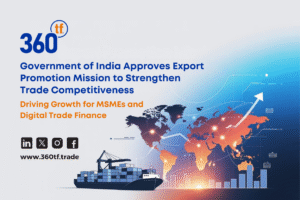As global supply chains evolve, the Indian Ocean region has emerged as one of the most dynamic and influential trade corridors. This concluding article in the Indian Ocean Corridor series brings together the structural insights from earlier pieces and the broader transformation shaping maritime trade, finance, and digital infrastructure.
If you missed the previous articles, you can explore them here:
• Western Indian Ocean Corridor: East Africa–Gulf–South Asia connectivity and port development
• The Indian Ocean: A Strategic Hub: Chokepoints, supply chain resilience, and trade finance implications
A New Maritime Ecosystem Is Emerging
Historically, maritime trade was dominated by a few established global players. Today, emerging economies along the Indian Ocean rim are reshaping this landscape. Their focus is shifting from being transit points to becoming active contributors to global value chains.
Across the region, countries are modernising ports, digitising operations, building domestic maritime industries, and strengthening regulatory and financial frameworks. This transition reflects a growing ambition: not just to participate in trade, but to shape its architecture.
Where Growth Is Taking Shape
- India is modernising ports under the Sagarmala Programme and the Maritime India Vision 2030, integrating digitisation and expanded shipyard capabilities
- UAE and Saudi Arabia are broadening their global logistics footprint through DP World and AD Ports, while developing green shipping corridors and multimodal logistics hubs under long-term national strategies.
- Kenya and Tanzania are deepening East Africa’s role through the LAPSSET Corridor and expansions at Mombasa and Dar es Salaam ports.
- Indonesia is investing in maritime logistics, shipbuilding, and energy infrastructure under its Nusantara Vision.
- Mauritius is developing capabilities in maritime arbitration, ocean economy services, and sustainable blue economy initiatives.
These developments, while national in focus, collectively signal a broader regional shift toward sovereign logistics strength and value retention.
Reimagining Maritime Finance & Insurance
As maritime capability grows, financial infrastructure must keep pace. Emerging economies are expanding access to more sophisticated, scalable trade finance tools:
- Regional cooperation frameworks like the East Africa Marine Insurance Protocol are strengthening local underwriting capacity.
- Bilateral partnerships, such as India–UAE engagement, support cargo insurance and trade credit solutions that help exporters mitigate risk.
- Mauritius is developing dispute resolution mechanisms suited to maritime commerce.
- Technological advances including AI risk scoring, parametric insurance, and digital policy issuance are enabling more precise and responsive marine insurance models.
This evolution distributes risk more fairly and supports participation from smaller exporters and logistics providers.
Digital Trade Corridors: Where Sea-Lanes Converge With Data
The future of maritime trade will be not only physical but digital. New layers of technology are aligning with port expansion, creating integrated trade corridors powered by real-time data and interoperable systems.
Key developments include:
- Digital based electronic bills of lading (eBLs) and eUCP-compliant documentation
- National single-window platforms integrating customs, ports, and logistics
- AI-driven vessel compliance and sanctions tools
- API-based trade finance platforms that enable real-time access to LC confirmation, receivables financing, FX, and cross-border liquidity
These shifts help reduce documentation friction, increase transparency, and strengthen the financial backbone of maritime trade. In this context, digital trade finance platforms, including those operated by 360tf play an important role in enhancing liquidity access and enabling seamless multi-market connectivity.
Reviving South–South Maritime Collaboration
One of the most enduring themes in the Indian Ocean’s history is the strength of South–South trade. Today, this is re-emerging through structured cooperation:
- The Indian Ocean Rim Association (IORA) prioritises collaboration in blue economy, fisheries, ocean energy, and coastal management.
- Countries such as Kenya, Mozambique, Madagascar, and Mauritius are partnering on marine research, aquaculture, and coastal development.
- Frameworks like the Nairobi Convention enable joint regional action on marine environmental protection.
- Research institutions, including IRD, support capacity building in ocean governance and coastal development.
This renewed cooperation aims to create sustainable, resilient maritime economies that balance growth and environmental stewardship.
Toward a Shared Maritime Future
The Indian Ocean is becoming more than a transit route, it is evolving into a co‑created maritime economy, shaped through collaboration, technology, and regional agency. While traditional maritime powers remain important, the architecture is shifting to reflect more balanced regional participation.
As trade finance becomes increasingly digital, trusted platforms like 360tf are playing a vital role: connecting exporters, financial institutions, and trade corridors in real time, while facilitating liquidity, transparency, and operational efficiency.
Conclusion:
The transformation across the Indian Ocean basin is not only about ships and ports. It is about participation, capability, and collaboration. Emerging economies are moving from being peripheral actors to becoming architects of a more inclusive and diversified global trade model.
For businesses, this shift creates new opportunities.
For financial institutions and digital trade platforms, it strengthens the mandate to deliver clarity, liquidity, and speed.
For global trade, it marks the rise of a more distributed, resilient, and interconnected maritime ecosystem.
The ocean has always connected the world.
Today, it is helping balance it.
Tomorrow, it will shape how global trade grows, collaboratively, sustainably, and digitally.




